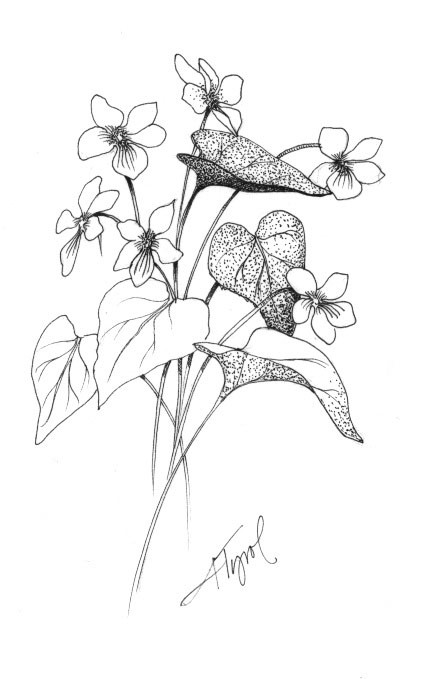
Wildflowers, ferns, mosses, and mushrooms narrate a rich story of the woods. They provide clues about climate, they disclose long-forgotten tales of hardscrabble farms, and they tell us worlds about soils and nutrients.
The stories are rarely simple, though. New England plants end up in certain habitats based on a wide variety of factors: soils, hydrology, climate, bedrock, elevation, and human history all interact to create a confusing set of possibilities, so plants are not always faithful to specific habitats.
Nevertheless, we can generalize about some plants.
Wood nettle (Laportea canadensis), for one, grows chiefly in moist, high-nutrient situations, whether on a hill’s slope or in a river’s floodplain. If you encounter large patches of nettle (and encounter is the word) at the base of a forested slope, chances are the soil will be deep, rich, and loamy. Wood nettle commands your attention when you touch the broad leaves, but it blooms without notice, producing inconspicuous, greenish flowers in late summer.
In a rich, wood-nettled forest, Canada violet (Viola canadensis) and the fragrant-rooted wild ginger (Asarum canadense) will turn up, too. Maidenhair fern (Adiantum pedatum) will carpet the slopes with its fan-shaped fronds. Butternut, basswood, sweet birch, and black cherry grow well in these rich soils, along with the more common sugar maple, ash, and beech.
An abundance of Canada mayflower (Maianthemum canadense), on the other hand, tends to suggest the soils are poorer, like acidic glacial till or sandy outwash. This plant, also called false lily-of-the-valley, grows only two to five inches tall, with one or two egg-shaped leaves and a spike of tiny white flowers that appear in late summer. The berries are distinctively mottled, red and brown.
Canada mayflower is a very common forest floor herb, and can grow sporadically in almost any soil, rich or poor. But when it is so bountiful that it carpets the ground, it demonstrates that soils are so poor that not much else can grow. The rich-woods plants can’t survive there, so mayflower fills in the gaps.
Forest Ecologist Bill Leak, in a U.S. Forest Service publication “Why Trees Grow Where They Do,” associates beech, red maple, yellow birch, and paper birch with some sites where mayflower is abundant. In other cases, pine dominates.
When Canada mayflower grows together with bluebead lily (Clintonia borealis), mountain sorrel (Oxalis montana), and shining clubmoss (Lycopodium lucidulum), the environment is likely to be cool, with shallow, rocky soils. Often, spruce, fir, yellow birch, and paper birch accompany these herbs. This association is common on high mountain slopes, but can also indicate a cool microclimate at lower elevations.
Mountain sorrel has ties with shamrock. Sorrel has more delicate three-parted leaves than shamrock, and has white flowers with pink veins. Clintonia, a yellow-flowered plant in the lily family, bears the name of DeWitt Clinton, 19th century governor of NewYork.
Plants tell the human story in more than just their names. Americans have cultivated an Asian plant, the day lily (Hemerocallis fulva), since the days of early settlement. An 1896 botany textbook describes the plant as “common in old gardens.” One hundred years later, the same can be said. In the woods, day lily may clue us in to the site of an old homestead when no other evidence appears. Further exploration might turn up a cellarhole nearby, or a stone wall. Perhaps an old apple tree or lilac will persist, too. Gordon Whitney, in his book From Coastal Wilderness to Fruited Plain, lists live-forever (Sedum telephioides), periwinkle (Vinca minor), and lily-of-the-valley (Convallaria majalis) as other Old World garden plants found near old homesites.
Many of our agricultural weeds came from the Old World as well, and in some kinds of woods (especially dry, rocky sites) they can stay on long after farmland has been abandoned. Mullein (Verbascum thapsus), with its tall, persistent flower spikes, Canada thistle (Cirsium arvense), which is not from Canada as its name suggests, and orange hawkweed (Hieracium aurentiacum), also known in these parts as Indian paintbrush, routinely outlast pasture grasses or crops.
Native North American hawkweeds and thistles grow in our woods, too. Rattlesnake-weed (Hieracium venosum) is a hawkweed with yellow dandelion-like flowers and striking red-veined leaves. It thrives naturally in Vermont woods, indicating dry, warm conditions. It is usually found under oaks or hickories in the southern Champlain Valley and the Taconics.
Rich woods have their nettles, sandy woods the mayflower, dry woods rattlesnake weeds, and old fields the plants that Europeans brought. Countless other stories can be told. Newcomb’s Wildflower Guide describes and illustrates the wild plants of the Northeast and tells where each is likely to grow. Wetland, Woodland, Wildland: A Guide to the Natural Communities of Vermont integrates descriptions of the trees, plants, animals, and habitats of 80 different wetland and terrestrial natural community types in Vermont and neighboring states.

